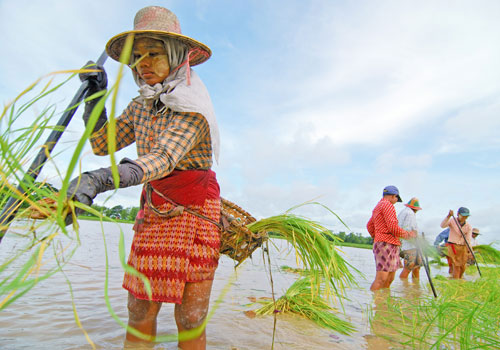Myanmar: Exports prioritised to meet trade target
According to official figures from the Ministry of Commerce, trade volume reached US$23 billion until the end of January in this fiscal year. The ministry has set the target trade volume to be $31 billion, therefore the ministry will continue trying to achieve its target over the next two months, said U Khin Maung Lwin, deputy secretary from the Ministry of Commerce.

Farmers prepare paddy field for rice harvest. Kaung Htet / The Myanmar Times
“Many imports have declined [in terms of volume]. Cement import has also fallen. Natural gas export has also fallen by billions of tonnes. At present, we are trying to reach our target $31 billion,” he said. Natural gas is Myanmar’s main export and major source of export revenue. The sector has struggled amid decline in global oil prices.
The official figures suggest that there was a total of trade worth more than $23 billion from the start of the fiscal year until February 10, slightly up from more than $22 billion in the same period last year.
Until the end of February 2017, over a span of 10 months, the total import volume was slightly above $13 billion. Thus, the volume fell by almost $450 million this year when compared to the $14 billion in the same period last year.
Import of investment goods amounted to $5420 million and commercial raw materials $4857 million. Consumer goods of more than $3262 million have also been imported, according to the Ministry.
The Ministry of Commerce has set a target for the import volume to reach $17 billion before the next fiscal year.
However, so far the volume has just amounted to some $13 billion, resulting from a decline in importing goods into the country as well as a sharp drop in cement import, said U Khin Maung Lwin.
The cement import has fallen by $121 million or 1.4 million tonnes compared to the same period last year. This change is due to a significant increase in domestic production, he explained.
In contrast, export reached $9663 million from the start of the fiscal year until February 10, up from $9159 million in the same period last year.
Therefore, import revenues have fallen by $450 million while exports have increased by more than $500 million.
Although, exports have increased, the main national export product – natural gas – has lost nearly a billion dollars in trade, and agricultural exports, such as rice, have also dropped due to bad weather, floods and seizures by the Chinese government in an attempt to crack down on illegal border trade, according to the civil servant.
“The current [level of] natural gas export of the nation has plunged and billions of dollars has been lost. The natural gas export dip is really noticeable,” another official added, “But this also meant that the amount of goods in the private sectors [which were exported] has risen. We can now only export about $2.4 billion worth of natural gas. Previously, the amount was up to $3.7 billion, so there was a drop of $1.3 billion worth of gas export.”
In December, the Myanmar Times reported that, as of December 9, the country had earned US$1.82 billion from selling natural gas abroad, compared to $3 billion by the same stage in the previous fiscal year, U Khin Maung Lwin remarked at that time. The impact on export revenues has continued since then.
The drop in gas export earnings is particularly worrying given that natural gas has typically accounted for around half of total export earnings in any given financial year.
The rice exports were estimated to be down by 200,000 tonnes, but have increased in the field of border trade. The trend was disrupted between September and November, during which border trade was hard hit by a crackdown on illegal trade by China.
Last October, industry insiders reported that many farmers faced serious losses as the Chinese border authorities tightened controls over the import of agricultural products from Myanmar, including rice, maize, sugar and beans.
At that time, Myanmar Rice Federation (MRF) joint secretary U Nay Lin Zin told the Myanmar Times that Myanmar has no real market for its rice except for China.
“But China has now reduced its import volume fivefold,” he said, adding that Myanmar was exporting about 5000 tonnes of rice a day to China at the Muse border gate, but the volume was reduced to less than 1000 tonnes.
“I think China is trying to stop illegal border trade completely. We have to start looking for new markets or other solutions,” said U Nay Lin Zin.
It remains to be seen how the situation of border trade could be completely resolved.
The export revenues in various sectors were: (1) more than $2362 million deriving from agricultural products, (2) more than $8 million from animal products, (3) more than $470 million from fisheries, (4) above $813 million from minerals, (5) above $204 million from forest products, (6) above $4497 million from finished industrial goods, and (7) more than $1306 million from other types of products. Finished industrial goods topped the revenue table while animal products contributed the least.
“Private sector exports, in the area of cut-make-pack garments, have increased up to $800 million,” said U Khin Maung Lwin.
The three months covering September, October and November witnessed a series of floods affecting the entire country, disrupting agriculture and manufacture sectors.
The Ministry of Commerce has also carried out re-export plans in order to stem the tide of falling trade activities.
Nevertheless, to meet the target of having $31 billion in exports before the start of the next fiscal year, attempts will be made to achieve the remaining $7 billion, and exports will be prioritised to accomplish the task, said U Khin Maung Lwin.
Source: http://www.mmtimes.com/index.php/business/25069-exports-prioritised-to-meet-trade-target.html


 Thailand
Thailand




